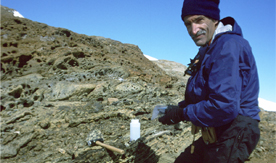
Scientists in Poland Name New Minerals for UMaine Geologist
Russian geologists at the University of Silesia in Poland have discovered two minerals new to science and have named them “edgrewite” and “hydroxledgrewite” in honor of University of Maine geologist and research professor Edward Grew.
The new minerals were discovered by mineralogists Evgeny Galuskin and Irina Galuskin in the Chegem caldera in the Northern Caucasus, near Mount Elbrus in the Kabardino-Balkaria Republic in Russia. A caldera is a crater-like structure produced by very large explosive volcanic ash eruptions, like those found Yellowstone and Crater Lake national parks.
Grew began working with the Galuskins as associate editor of the journal American Mineralogist, when he helped them prepare papers for publication, and in person at the International Mineralogical Association meeting in Budapest in 2010. The Galuskins were familiar with Grew’s reputation for working successfully with Russian scientists throughout his career.
The honor of having a mineral named for him “is a lifelong dream come true,” says Grew, whose research focuses on rare minerals containing boron and beryllium, and the role of the two elements in the changes that rocks undergo at high temperatures and pressures in the Earth’s crust. “I have always valued my international collaborations in science, and so I was especially honored that colleagues in Europe proposed my name for the new minerals they discovered.”
A UMaine research faculty member for 28 years, Grew has been involved in the discovery and characterization of 13 new minerals, including six from Antarctica. He has been on nine expeditions to Antarctica with researchers from the former Soviet Union, Australia, Japan and the United States, in addition to research projects in Australia, India, Germany, Japan, Tajikistan and Siberia. His first expedition to the Antarctic was in 1972–74, when he wintered at Molodezhnaya Station. He has published extensively on the composition and evolution of minerals, and has served in leadership capacities for national and international professional organizations and mineralogical publications.
Identifying undiscovered minerals involves detailed microscopic analysis. Edgrewite and hydroxledgrewite were found as tiny crystals smaller than the period at the end of a sentence in a newspaper, according to Grew.
“Recognizing a new mineral involves a measure of good luck and familiarity with known minerals,” he says. “Several new minerals I have discovered simply looked different under the optical microscope. Chemical tests confirmed my hunch that the minerals were new. Sometimes a new mineral does not stand out optically under the microscope, but (its) distinctive chemical composition suggests it is new. Once a mineral is suspected to be new, it is studied in detail so its physical, chemical and crystallographic properties are fully characterized and then it must undergo a complex process of approval by an international commission.”
The Galuskins and research colleagues from four European countries discuss the discovery of the new minerals edgrewite and hydroxledgrewite in a peer-reviewed scientific report in the November–December issue of the journal American Mineralogist.
Contact: George Manlove, 207.581.3756
